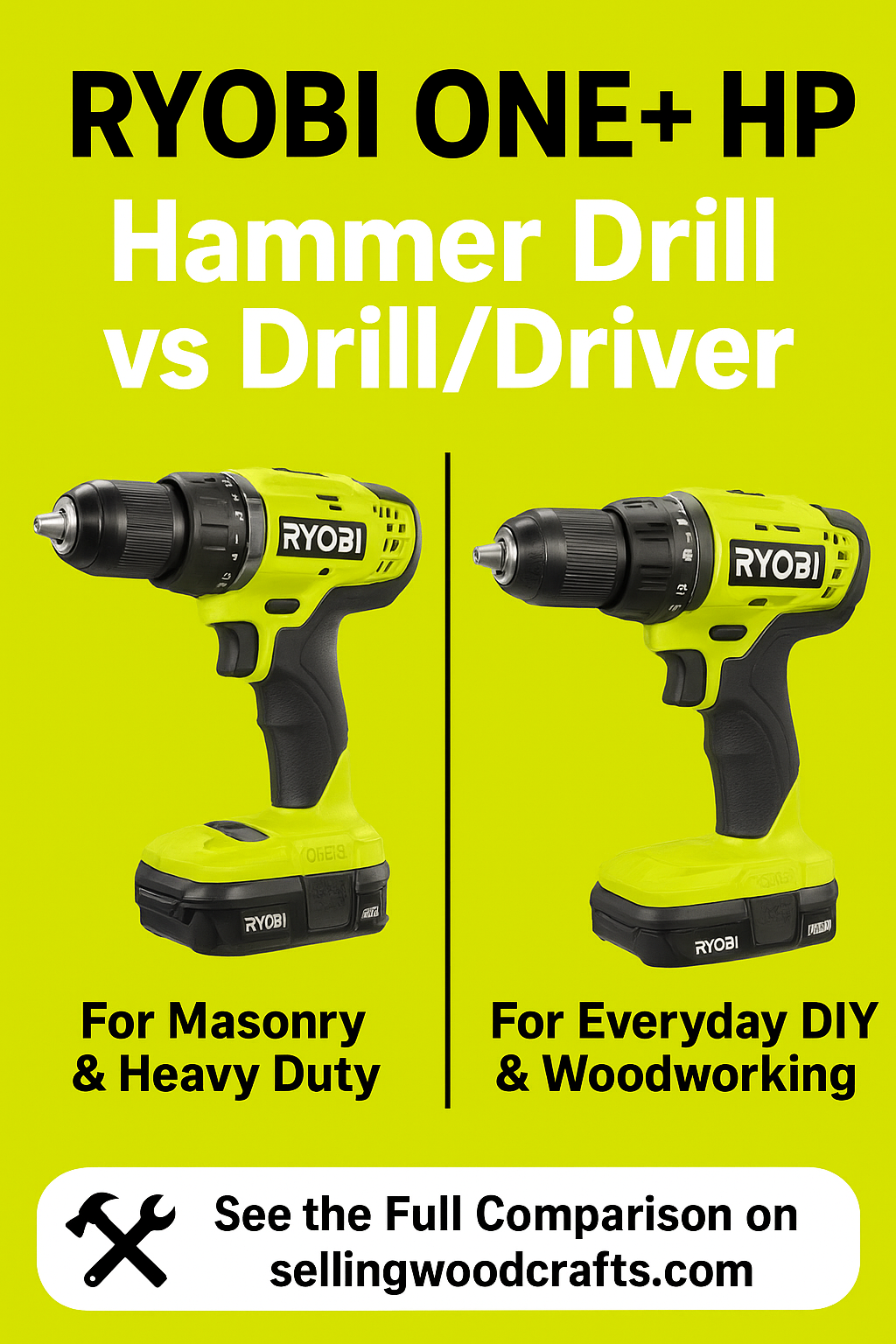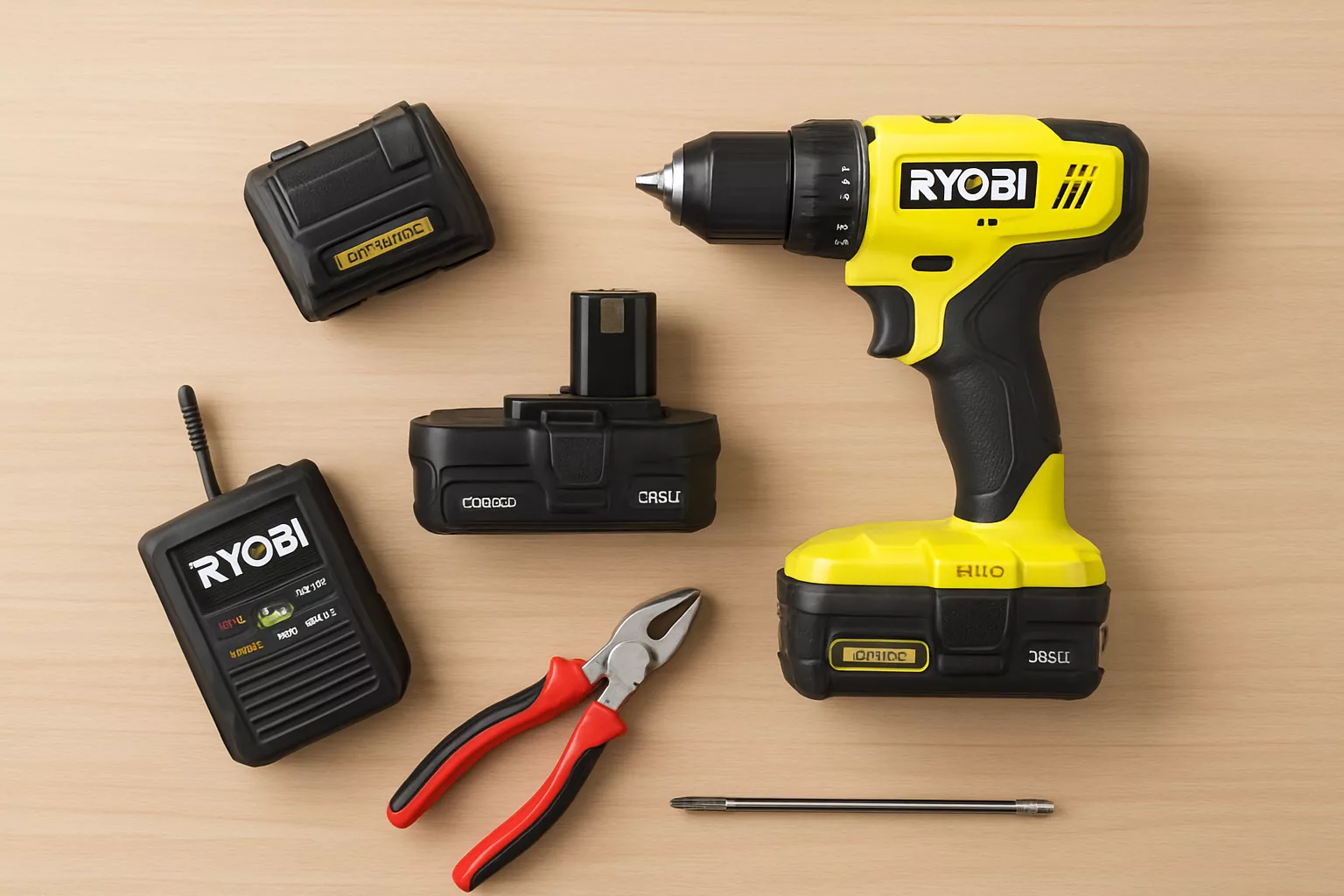“Ryobi ONE+ HP review”, “Ryobi 18V brushless comparison”, and “best drill for DIY woodworking”.

Ryobi Hammer Drill vs Drill Driver: Which 18V ONE+ HP Tool Should You Buy?
If you’ve spent any time shopping the RYOBI ONE+ HP 18V brushless lineup, you’ve probably noticed two tools that look almost identical: the RYOBI ½” Hammer Drill and the RYOBI ½” Drill/Driver.
Both promise compact power, brushless efficiency, and the convenience of ONE+ batteries—but which one actually belongs in your toolbox? Let’s break it down.
What’s the Difference Between a Hammer Drill and a Drill/Driver?
At first glance, these drills share the same DNA:
- 18V ONE+ HP brushless motor
- 2-speed gearbox (0–500 / 0–2,100 RPM)
- ½” ratcheting metal chuck
- 24-position clutch
- LED worklight
- 3-year warranty
The real difference? The hammer function.
- A hammer drill doesn’t just spin the bit—it pulses forward and back, delivering up to 34,000 blows per minute (BPM). That impact action is what lets you chew through brick, block, and concrete.
- A drill/driver skips the hammer mode and focuses on smooth, controlled drilling and driving in wood, metal, and fasteners.
RYOBI ONE+ HP Brushless ½” Hammer Drill Kit
The hammer drill is the heavyweight of the two.
Key Specs:
- Torque: 750–850 in-lbs (depending on model)
- Speeds: 0–500 / 0–2,100 RPM
- Hammering Action: 0–34,000 BPM
- Extras: LED light, metal chuck, 24-position clutch
Best For:
- Masonry drilling (brick, block, stone, concrete)
- Deck builds, anchors, heavy-duty installs
Why Choose It:
If your projects ever take you into masonry or concrete, you need hammer mode. Without it, even the best drill will stall out.
RYOBI ONE+ HP Brushless ½” Drill/Driver Kit
This one’s the everyday champ—lighter, slightly cheaper, and usually bundled with extra batteries.
Key Specs:
- Torque: 750 in-lbs
- Speeds: 0–500 / 0–2,100 RPM
- Extras: Often includes two 2.0 Ah high-performance batteries
Best For:
- Woodworking (furniture, cabinets, shelving)
- General home DIY
- Metal drilling and screw driving
Why Choose It:
You’ll use this 90% of the time. It’s versatile, powerful, and the dual-battery kits mean less downtime between charges.
Side-by-Side Comparison: Ryobi Hammer Drill vs Drill Driver
| Feature | Hammer Drill | Drill/Driver |
|---|---|---|
| Hammer Mode | Yes (up to 34k BPM) | No |
| Torque | 750–850 in-lbs | 750 in-lbs |
| Speed | 0–500 / 0–2,100 RPM | 0–500 / 0–2,100 RPM |
| Clutch Settings | 24 positions | 24 positions |
| Chuck | ½” ratcheting metal | ½” ratcheting metal |
| Batteries in Kit | Usually 1× 2.0 Ah | Often 2× 2.0 Ah HP batteries |
| Best For | Masonry, heavy-duty drilling | Everyday drilling & fastening |
Which RYOBI Drill Should You Buy?
- Choose the Hammer Drill if you’ll be drilling into brick, block, stone, or concrete. It’s the only way to get through masonry cleanly.
- Choose the Drill/Driver if your projects are mostly woodworking, furniture, and general DIY tasks. The extra batteries in the kit make it more practical for long projects.
- Best of Both Worlds: If your budget allows, own both. Use the drill/driver as your daily go-to and keep the hammer drill ready for those heavy-duty jobs.
Final Word
When comparing the Ryobi Hammer Drill vs Drill Driver, the answer depends on your project list:
- Everyday DIY? Go with the drill/driver.
- Masonry or concrete jobs? Get the hammer drill.
- Want a full shop setup? Grab both and never look back.
Both tools deliver pro-level power, compact size, and the convenience of the RYOBI ONE+ 18V battery system—so whichever you choose, you’re adding a serious upgrade to your toolkit.
Friendly conclusion: If you’re searching for the best RYOBI drill for woodworking and DIY projects, the Drill/Driver Kit is your everyday winner. If you need masonry drilling power, the Hammer Drill Kit is the clear choice.
